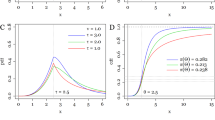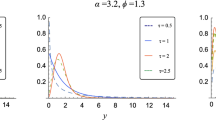Abstract
Density estimators that can adapt to asymmetric heavy tails are required in many applications such as finance and insurance. Extreme value theory (EVT) has developed principled methods based on asymptotic results to estimate the tails of most distributions. However, the finite sample approximation might introduce a severe bias in many cases. Moreover, the full range of the distribution is often needed, not only the tail area. On the other hand, non-parametric methods, while being powerful where data are abundant, fail to extrapolate properly in the tail area. We put forward a non-parametric density estimator that brings together the strengths of non-parametric density estimation and of EVT. A hybrid Pareto distribution that can be used in a mixture model is proposed to extend the generalized Pareto (GP) to the whole real axis. Experiments on simulated data show the following. On one hand, the mixture of hybrid Paretos converges faster in terms of log-likelihood and provides good estimates of the tail of the distributions when compared with other density estimators including the GP distribution. On the other hand, the mixture of hybrid Paretos offers an alternate way to estimate the tail index which is comparable to the one estimated with the standard GP methodology. The mixture of hybrids is also evaluated on the Danish fire insurance data set.
Similar content being viewed by others
References
Choulakian, V., Stephens, M.A.: Goodness-of-fit tests for the generalized Pareto distribution. Technometrics 43, 478–484 (2001)
Corless, R.M., Gonnet, G.H., Hare, D.E.G., Jeffrey, D.J., Knuth, D.E.: On the Lambert W function. Adv. Comput. Mat. 5, 329–359 (1996)
Danielsson, J., de Haan, L., Peng, L., de Vries, C.G.: Using the Bootstrap method to choose the sample fraction in tail index estimation. J. Multivar. Anal. 76, 226–248 (2001) (Sample: Extreme Quantile and Probability Estimation, Financial Markets Group)
Davison, A.C., Smith, R.L.: Models for exceedances over high thresholds. J. R. Stat. Soc., Ser. B Stat. Methodol. 52, 393–442 (1990)
Dupuis, D.J.: Exceedances over high thresholds: a guide to threshold selection. Extremes 1, 251–261 (1998)
Embrechts, P., Kluppelberg, C., Mikosch, T.: Modelling Extremal Events. Springer-Verlag, Berlin (1997)
Fama, E.F.: The behavior of stock market prices. J. Bus. 38, 34–105 (1965)
Frigessi, A., Haug, O., Rue, H.: A dynamic mixture model for unsupervised tail estimation without threshold selection. Extremes 5, 219–235 (2002)
Hosking, J.R.M., Wallis, J.R.: Parameter and quantile estimation for the generalized Pareto distribution. Technometrics 29, 339–349 (1987)
Kang, S., Serfozo, R.F.: Extreme values of phase-type and mixed random variables with parallel-processing examples. J. Appl. Probab. 36, 194–210 (1999)
Liu, C., Rubin, D.B., Liu, C., Rubin, D.B.: Weighted finite population sampling to maximize entropy. Biometrika 81, 633–648 (1994)
Mandelbrot, B.: The variation of certain speculative prices. J. Bus. 36, 394–419 (1963)
McNeil, A.J.: Estimating the tails of loss severity distributions using extreme value theory. ASTIN Bull. 27, 117–137 (1997)
McNeil, A.J., Frey, R.: Estimation of tail-related risk measures for heteroscedatic financial time series: an extreme value approach. J. Empir. Finance 7, 271–300 (2000)
Pickands, J.: Statistical inference using extreme order statistics. Ann. Stat. 3, 119–131 (1975)
Pollard, D.: Strong consistency of the K-means clustering. Ann. Stat. 9, 135–140 (1981)
Priebe, C.E.: Adaptive mixtures. J. Am. Stat. Assoc. 89, 796–806 (1994)
Rockafellar, R.T., Uryasev, S.: Conditional value-at-risk for general loss distributions. J. Bank Finance 26, 1443–1471 (2002)
Smith, R.L.: Maximum likelihood estimation in a class of nonregular cases. Biometrika 72, 67–90 (1985)
Smith, R.L.: Estimating tails of probability distributions. Ann. Stat. 15, 1174–1207 (1987)
Author information
Authors and Affiliations
Corresponding author
Rights and permissions
About this article
Cite this article
Carreau, J., Bengio, Y. A hybrid Pareto model for asymmetric fat-tailed data: the univariate case. Extremes 12, 53–76 (2009). https://doi.org/10.1007/s10687-008-0068-0
Received:
Revised:
Accepted:
Published:
Issue Date:
DOI: https://doi.org/10.1007/s10687-008-0068-0




